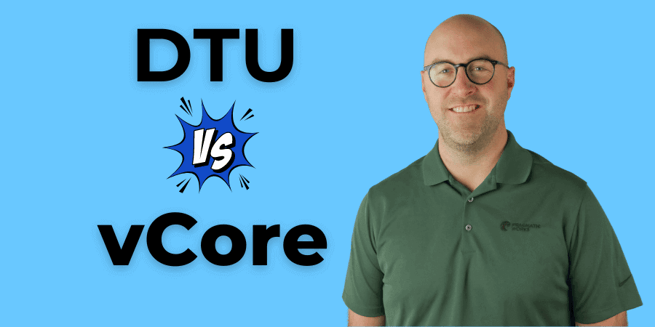DTU vs vCore in Azure SQL Database

If you’re just starting out with Azure SQL Database, you may have questions about the difference between the DTU and vCore pricing models. I’d like to clear up some of those questions.
Let me start by pointing out that whether you’re using DTU or vCore pricing with Azure SQL Database, the underlying service is the same. The difference between DTU and vCore really has to do with how the service is billed and how you allocate databases.
What is a DTU?
A little history here—the DTU (Database Transaction Unit) model was the first to be introduced with Azure SQL DB. DTU is a measure; a blend of CPU memory and IO. The idea was to create a measure that would give us a relative idea of the amount of power or resources behind the database – the higher the number of DTUs, the more powerful database we had.
The range of DTUs went from 5 on the low end to up to 4,000 on the high end. The problem for many was not knowing exactly what a DTU is. After a while, Microsoft acknowledged that question and introduced the vCore pricing. vCore is short for virtual core and it’s a model that was designed to make it simpler to translate your on prem hardware resource specs into similar specs on the Azure SQL database platform.
For example, if you’re pricing by vCore, you have some visibility into the actual amount of RAM that’s available to you, as well as some idea of the type of processor and the speed of the processor that’s being used on the hardware. With the DTU model, all of that is just part of the service, so you’re not aware of those specifics.
DTU vs vCore Pricing
A few notes:
- It’s important to note that in both cases the service is priced per database.
- With the DTU model you pay one fixed price for your compute (or IO/memory), as well as your data storage and back up retention.
- With the vCore model you have separate charges for your compute (what type of node or compute power you’re using) and a separate charge for your storage. Using vCore you have more flexibility in managing your costs than with DTU.
- You don’t have to choose one or the other when you’re getting started, you can switch between the DTU and vCore models.
Which One Should You Use - DTU or vCore?
So, you may ask, which one should I use? The simple answer, it depends. The DTU model is simpler as far as the number of options that you have and the number of ‘levers to pull’ – one fixed price includes everything. The vCore model gives you more flexibility and transparency into what you’re paying for.
In short, for simplicity, the DTU model has an advantage. Plus, if you’re just getting started with Azure SQL Database, the DTU model offers more options at the lower end of performance, so you can get started at a lower price point than with vCore.
Microsoft Software Assurance
If you have software assurance with Microsoft and are familiar with how that works, there are some advantages there to using vCore. If you’re not familiar with software assurance, you may want to start with the DTU model.
If you have questions about Azure SQL Database, the Azure platform and anything related to Azure or data for your business, you’re in the right place. Click the link below or contact us – we’re here to help no matter where you are on your cloud journey.
Don't forget to check out the Pragmatic Works' on-demand learning platform for more insightful content and training sessions on Azure and other Microsoft applications. Be sure to subscribe to the Pragmatic Works YouTube channel to stay up-to-date on the latest tips and tricks.
Sign-up now and get instant access

ABOUT THE AUTHOR
Austin is a Jacksonville native who graduated from The Baptist College of Florida in 2012. He previously worked as a manager in the retail service industry. He enjoys spending time with his wife and two kids. His primary focus at Pragmatic Works is on Azure Synapse Analytics and teaching the best practices for data integration, enterprise data warehousing, and big data analytics. He also enjoys helping customers learn the ins and outs of Power BI and showing people new ways to grow their business with the Power Platform.
Free Trial
On-demand learning
Most Recent
private training







-1.png)
Leave a comment